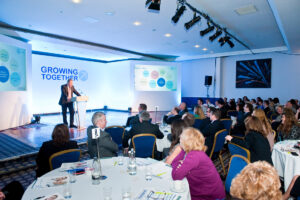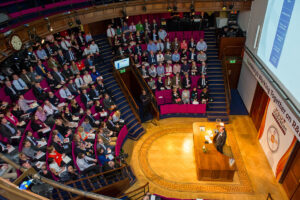A great article published on Event Brite’s blog.
https://www.eventbrite.co.uk/blog/make-an-event-more-environmentally-sustainable-ds00/
1. Work out your impact
Before you try and improve things, you need to know what impact your event is already having on the environment. It doesn’t always follow, but higher carbon impacts tend to go hand-in-hand with increased costs.  The best example of this is managing power consumption and transport. However this also rings true in the use of (often unnecessary) disposable materials, which add to the disposal bill and also the cleansing bill if they become litter.
The best example of this is managing power consumption and transport. However this also rings true in the use of (often unnecessary) disposable materials, which add to the disposal bill and also the cleansing bill if they become litter.
Dividing up environmental impacts into groups like the ones below can make them easier to manage. When I’m speaking to event organisers who are short of time, I usually suggest that they introduce one impact area each year to measure and try to reduce.
Consider the public profile of a particular impact area; for example this could be your food waste. To reduce this, you could capitalise on Hugh Fearnley-Whittingstall’s campaign about food waste by running your own in-event campaign to reduce food waste – you could even ask him to come along!
2. Make a plan
As with everything in event management, if you don’t plan properly it will either go wrong, or possibly not happen at all. Once you’ve chosen which environmental impacts you’re going to focus on, you should set some realistic goals which you can improve on each year.
It might sound obvious, but you need to think about when you’re going to get everything done. This is not just about planning when you’re going to implement your project but when you’re going to achieve the targets you’ve set. Create milestones and stick to them.
There’s no point in going to a lot of effort if you can’t work out whether your plans have worked; so make sure you decide what you’re going to measure before you get started. This could be anything from the percentage of waste you got recycled, or the amount of diesel you used. For your catering, you could audit whether all your contractors used the local food supplier you told them to use.
3. Involve your contractors
Delegating tasks to your project team can lighten your load, but if you pass them on to your contractors then it can free up time for your whole team. The best time to get input from contractors is when they’re bidding for the job. They’ll really think outside the box to look better than another bidder, so make sure you stipulate that you want their help with reducing environmental impacts.
A good example if you’re running an outdoor event is to get your power contractor to start measuring power usage using remote monitoring systems. These systems can tell you how much power is actually being used by your generators in different parts of the show.
Make sure you involve contractors early so that they have plenty of time to prepare. I’ll never forget the year when the bar contractor at a major festival turned up with a billion shattering plastic glasses, utterly destroying the beautiful deer park and leaving tiny shards of plastic in the mud forevermore. Had we been better prepared we would have contractually obliged them to ensure that their glasses were shatter-proof. These days I encourage event organisers to put clauses in their contracts which oblige caterers and bars to serve their food and drinks in recyclable serve-ware; ensuring first that we’ve got somewhere local to recycle the material before we tell them which materials to use.
4. Organise essential waste management
Okay, as a waste manager of 15 years I’m biased, but I have to say that providing recycling bins for your public is a must in this day and age. Most event-goers will visit a bin at least once or twice during a show, so it’s an ideal opportunity to show them that you care about the environment and enhance your overall brand.
Choosing the right bin is important. Signage should be clear and bold and state exactly what needs to go in each bin. Avoid long lists of dos and don’ts which will confuse the hell out of people especially after a couple of ales. There’s no point in taking a standard bin and plonking a sign on the side at knee height, no one will see it and the recycling will get contaminated. Restricting the aperture is also a good plan, it gets people to think twice before they throw something in – if you take a wheelie bin and simply flip the lid up they fill it with anything and everything. There are plenty of contractors around these days who’ve got bespoke event equipment like the ones in the picture below from Critical Waste; don’t stand for anything less.
Make sure that your contractor is being honest about what happens to your waste too. Make it part of their contract to tell you where the rubbish and recycling has gone and do some poking around to make sure they’ve told you the truth. They’re legally obliged to provide you with a duty of care note which shows you when and where the recycling was taken.
Remember that ‘waste-to-energy’ (i.e. incineration) is not the same as recycling so you have to be careful what to report. Zero waste to landfill might be a good slogan but it’s not much use if you’re just burning all those valuable resources instead. Even better, why not consider re-using some of your waste materials or not using them in the first place.
It shouldn’t stop in the front of house areas. Providing recycling services for your catering units can really bump up your recycling figures. Food waste is one of the biggest problems in landfill because it breaks down without air and creates methane gas which is 25 times worse for the greenhouse effect than CO2.
5. Start simple
I think my favourite green initiative is around tackling audience transport which is thought to be the greatest impact area from most events, and in my view it’s also one of the easiest areas to tackle.
For many organisers, getting the punters to and from the venue is part of the planning process anyway. The main thing is to put the emphasis on the most sustainable method; discouraging single car use and encouraging walking and cycling. Dedicated coaches are a great way to bring in customers from other cities and it’s much better than having everyone travel by car. Mostly audience travel impacts can be sorted out by providing the best travel information.
Find out more about our events services.



